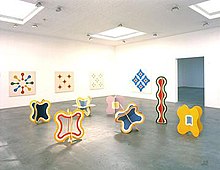Paul Feeley
| Paul Feeley | |
|---|---|

Installation of Paul Feeley's work at the Matthew Marks Gallery in 2002
|
|
| Born |
July 27, 1910 Des Moines, Iowa, U.S. |
| Died | June 10, 1966 (aged 55) New York, New York, U.S. |
| Nationality | American |
| Education | Art Students League |
| Known for | Painting |
| Movement | Color Field painting |
Paul Feeley (July 27, 1910 − June 10, 1966) was an artist and director of the Art Department at Bennington College during the 1950s and early 1960s.
The Estate of Paul Feeley is represented exclusively by Garth Greenan Gallery, New York.
Though Feeley was born in the same generation as the Abstract Expressionists, his mature style was hardly gestural; instead, according to Feeley, his paintings "just sat still and had a presence rather than some sort of an agitated fit." His greatest source of admiration was the Great Pyramids in Egypt. Gene Baro stated that Feeley's mature style did not overtly depend on any contemporary art movements of the time. His paintings are best summarized as follows:
Primarily a painter, Feeley favored canvases in which simple geometric forms are deployed singly or in repeating groups. He used upright barbell or baluster shapes, oblongs that resemble peanuts, small solid-looking arches and wavy-countered squares and rectangles. Fascinated with modularity, Feeley often surrounded his forms with white bands and colored borders that echo the contours of the central shape. While the paint handling in his work is always restrained and stencils were used to repeat forms, Feeley is not a "hard edge" painter; his geometry is too clearly of the handmade variety. The solid colors (predominantly red, blue, green, orange) are usually limited to two colors on a white ground, although the watercolors often use more hues per composition than the paintings.
In 1931, Feeley moved to New York to pursue his studies. He studied portrait painting with Cecilia Beaux, figure painting with George Bridgeman and Thomas Hart Benton, and mural painting from 1931-1934. In fact, in 1934, Feeley joined the Mural Painters Society of New York and became increasingly engaged with mural projects. From 1934-1939, he would teach at the Cooper Union, where he'd later become the head of industrial design. In 1940, he would join the staff at Bennington College, where he was fundamental in establishing its art department. Aside from a brief hiatus from 1943-1946, when he volunteered for service with the United States Marines, he remained committed to the art of his contemporaries, he exposed his students — Helen Frankenthaler among them — to many of the most significant artists of his time. He helped to organize the first retrospective exhibition of modernist sculptor David Smith, in 1951 and helped with the 1955 Hans Hofmann and the 1952 Jackson Pollock retrospectives which were both organized by Clement Greenberg. Feeley and Greenberg also organized a Kenneth Noland Exhibition at Bennington in 1961.
...
Wikipedia
